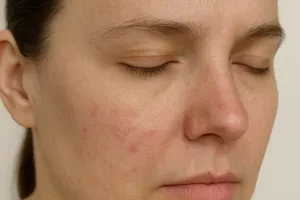Light is more than what we see through the window. It directs our rhythms, launches hormonal cascades, and influences how our skin functions and looks. From the first minutes of dawn to the quiet dusk, it shapes cortisol, serotonin, and melatonin levels, defining tone, radiance, sensitivity, and even the speed of regeneration. This article explores how to reclaim your natural rhythm and make light an ally of beauty.
Light as the Skin’s Metronome
Our eyes send light signals to the suprachiasmatic nucleus — the body’s master circadian clock. But the skin also has its own peripheral clocks that regulate cell division, sebum secretion, microcirculation, and barrier repair. According to Journal of Investigative Dermatology, circadian rhythms influence skin pH, temperature, hydration, and transepidermal water loss (TEWL).
When daylight is insufficient or we keep bright lights on late into the night, these rhythms get disrupted. The barrier weakens, TEWL increases, and the skin becomes more reactive. A study in the Journal of the American Academy of Dermatology showed that acute stress and circadian misalignment directly affect the integrity of the skin barrier.
Light and Hormones: The Invisible Mechanism
Light is the strongest natural regulator of our endocrine system. It’s perceived not only by the eyes but also by special photoreceptive cells that send signals to the hypothalamus, where the suprachiasmatic nucleus (SCN) orchestrates circadian rhythms. In response, the body adjusts its biochemistry: heart rate, temperature, and levels of cortisol, melatonin, and insulin shift — even enzymatic activity in the skin changes. The difference between morning sunlight and screen light at night is not aesthetic — it’s biological.
Morning light suppresses melatonin, the sleep hormone, and triggers cortisol production — the body’s natural “wake-up” signal. As Leproult & Cajochen (PNAS, 1997) demonstrated, morning light determines the timing of the cortisol peak. Without it, alertness, energy, and skin tone decline throughout the day.
Daylight sustains serotonin — the neurotransmitter of mood, balance, and vitality. During brighter months, serotonin levels rise, improving skin hydration and tone. In contrast, winter light deficiency lowers serotonin and often leads to dullness and emotional fatigue. A classic study by Rosenthal (1984) revealed that light deprivation reduces serotonin turnover — something your skin “feels” as much as your mood.
As the sun sets, natural light turns warmer, shifting from blue to golden-red wavelengths. This gentle transition signals the pineal gland to produce melatonin — not only a sleep regulator but a powerful antioxidant. Dermato-Endocrinology confirms that skin-derived melatonin reduces inflammation, supports collagen synthesis, and protects DNA from oxidative stress.
The day–night cycle is therefore more than a change of light. It’s a biochemical dialogue between the brain, skin, and hormones. When we let the body see true daylight in the morning and experience darkness and calm at night, we give the skin a precise map for recovery — it stops fighting and begins to work in harmony with nature.

How Light Spectra Affect the Skin
Light isn’t a uniform stream — it’s a spectrum of thousands of wavelengths, each interacting with our biology differently. The most important for skin are ultraviolet (UVA, UVB), visible (HEVIS), and infrared (NIR) ranges. Together they form a photobiological climate that governs barrier strength, pigmentation, and cellular energy.
Morning light. Early light is rich in blue wavelengths (≈480 nm) that activate melanopsin-containing cells in the retina, “starting” the body clock. Just 10–15 minutes of outdoor exposure is enough to signal that the day has begun. For skin, this means improved microcirculation, color, and balance.
Midday light. Around noon, UVB (290–320 nm) enables vitamin D synthesis, while UVA (320–400 nm) penetrates deeper and accelerates photoaging. This is when protection is vital. For details, read our guide “Sun Protection 360°”.
Visible and HEVIS light. Blue and violet light (400–500 nm) can contribute to oxidative stress and pigmentation, especially in skin types III–V. J Am Acad Dermatol, 2020 notes that antioxidant-rich or tinted HEVIS protection can reduce this effect.
Evening light. Natural evening light is soft and warm, emerging when the sun dips below the horizon. Its spectrum shifts toward golden-red, signaling the body to slow down. When darkness falls, artificial evening light — lamps and screens — takes over. Often too cool (4000–6500 K), it suppresses melatonin and prolongs alertness. Thus, evening skincare begins not with cream, but with a lamp: warm lighting around 2700 K helps the body close the day without hormonal stress.
Red and Infrared Light: The Scientific Perspective
Red and near-infrared light (600–900 nm) penetrate deeply into the dermis, reaching fibroblasts and mitochondria — the cell’s power plants. These wavelengths activate cytochrome c oxidase, increasing ATP production, a process known as photobiomodulation.
Under red light, mitochondrial energy rises, collagen synthesis improves, and nitric oxide promotes vasodilation and better microcirculation. These effects were confirmed in the meta-analysis by Avci et al., 2013 and recent reviews in Frontiers in Photonics, 2024. Researchers at Harvard Medical School also report reduced inflammatory cytokines and enhanced antioxidant enzyme activity after low-dose red-light therapy.
However, the effect is dose-dependent: moderate exposure is regenerative, but excessive light may cause overheating or irritation. Home devices (630–660 nm) are best used for 5–10 minutes, while clinical systems (up to 900 nm) require professional supervision. Red light isn’t just a trend — it’s part of a slow-beauty philosophy: light that doesn’t burn time but gently returns it to the cells.
The Architecture of Home Light
We often think of skincare as creams and serums, yet light is part of this care too. The way we illuminate our spaces defines how hormones, nerves, and skin respond.
- Morning: open the curtains, step outside, and let your eyes meet natural light — glass filters it too much.
- Daytime: take “light breaks” — short walks to balance serotonin and refresh focus.
- Evening: switch to warm indoor light (2700 K), reduce brightness, and turn off screens an hour before bed.
In other words, evening light is not a time — it’s an environment. The way we shape it determines whether the skin rests or keeps living in a daylight mode.
Conclusion
Light is not just what we see — it’s what shapes us. When we synchronize morning, day, and evening, the body reclaims its natural rhythm. The skin follows the plan: renewing, glowing, calm. Beauty stops being a mask and becomes a state — one where the body breathes, hormones balance, and the nervous system trusts.
Light is the silence in which the body remembers that all is well. In morning rays, it feels strength; in evening softness, peace. And perhaps within this harmony — between photons and breath, clarity and stillness — true beauty begins.









